Hadronization and Color Transparency †
Abstract
:1. Introduction
2. Model
2.1. Quantum-Kinetic Transport
2.2. Formation Times of Hadrons
2.3. Prehadronic Cross Sections
“A good, complete experimental program studying almost exclusive reactions in nuclei should be able to tell us which is the better formula at a given momentum transfer.”
3. Results
- 1.
- The nuclear radius must be of the same order as (or smaller than) the distance traveled by the newly formed hadron until it reaches its final, free cross section. If that distance is much larger than the nuclear dimension, most of the formation of the hadron takes place outside the nucleus, and, consequently, the observable effects of CT are maximized.
- 2.
- Even if the geometrical/kinematical constraint just discussed is met, the actual, measurable amount of CT depends on the specific time dependence of the cross section of the newly formed hadron with the target nucleons.
3.1. Time-Dependence of Prehadronic Cross Sections
3.2. HERMES Experiment
3.3. JLAB Experiments
3.3.1. JLAB Experiments with 5 GeV Beam
3.3.2. JLAB Experiments with 12 GeV Beam
3.4. Proton Transparency
4. Summary and Conclusions
Author Contributions
Funding
Data Availability Statement
Conflicts of Interest
References
- Dutta, D.; Hafidi, K.; Strikman, M. Color transparency: Past, present and future. Prog. Part. Nucl. Phys. 2013, 69, 1–27. [Google Scholar] [CrossRef] [Green Version]
- Bhetuwal, D.; Matter, J.; Szumila-Vance, H.; Kabir, M.L.; Dutta, D.; Ent, R.; Abrams, D.; Ahmed, Z.; Aljawrneh, B.; Alsalmi, S.; et al. Ruling out color transparency in quasielastic 12C(e,e′p) up to Q2 of 14.2 (GeV/c)2. Phys. Rev. Lett. 2021, 126, 082301. [Google Scholar] [CrossRef] [PubMed]
- Aitala, E.M.; Amato, S.; Anjos, A.C.; Appel, J.; Ashery, D.; Banerjee, S.; Bediaga, I.; Blaylock, G.; Bracker, S.B.; Burchat, P.R.; et al. Observation of color transparency in diffractive dissociation of pions. Phys. Rev. Lett. 2001, 86, 4773–4777. [Google Scholar] [CrossRef] [PubMed] [Green Version]
- Frankfurt, L.; Miller, G.A.; Strikman, M. Coherent QCD phenomena in the coherent pion nucleon and pion nucleus production of two jets at high relative momenta. Phys. Rev. D 2002, 65, 094015. [Google Scholar] [CrossRef] [Green Version]
- Collins, J.C.; Frankfurt, L.; Strikman, M. Factorization for hard exclusive electroproduction of mesons in QCD. Phys. Rev. D 1997, 56, 2982–3006. [Google Scholar] [CrossRef] [Green Version]
- Horn, T.; Qian, X.; Arrington, J.; Asaturyan, R.; Benmokthar, F.; Boeglin, W.; Bosted, P.; Bruell, A.; Christy, M.E.; Chudakov, E.; et al. Scaling study of the pion electroproduction cross sections and the pion form factor. Phys. Rev. C 2008, 78, 058201. [Google Scholar] [CrossRef] [Green Version]
- Kaskulov, M.M.; Mosel, U. Deep exclusive charged π electroproduction above the resonance region. Phys. Rev. C 2010, 81, 045202. [Google Scholar] [CrossRef] [Green Version]
- Larionov, A.; Strikman, M. Color transparency and hadron formation effects in high-energy reactions on nuclei. Particles 2020, 3, 24–38. [Google Scholar] [CrossRef] [Green Version]
- Kaskulov, M.M.; Gallmeister, K.; Mosel, U. Deeply inelastic pions in the exclusive reaction p(e,e′π+)n above the resonance region. Phys. Rev. D 2008, 78, 114022. [Google Scholar] [CrossRef]
- Kaskulov, M.M.; Mosel, U. Deep exclusive electroproduction of π+ from data measured with the HERMES detector at DESY. Phys. Rev. C 2009, 80, 028202. [Google Scholar] [CrossRef] [Green Version]
- Kadanoff, L.; Baym, G. Quantum Statistical Mechanics. Green’s Function Methods in Equilibrium and Nonequilibrium Problems; CRC Press/Taylor & Francis Group: Boca Raton, FL, USA, 1989. [Google Scholar] [CrossRef]
- Buss, O.; Gaitanos, T.; Gallmeister, K.; Van Hees, H.; Kaskulov, M.; Lalakulich, O.; Larionov, A.B.; Leitner, T.; Weil, J.; Mosel, U. Transport-theoretical description of nuclear reactions. Phys. Rep. 2012, 512, 1–124. [Google Scholar] [CrossRef] [Green Version]
- GiBBU: The Giessen-Boltzmann-Uehling-Uhlenbeck Project. Available online: http://gibuu.hepforge.org (accessed on 13 April 2022).
- Sjöstrand, T.; Mrenna, S.; Skands, P.Z. PYTHIA 6.4 physics and manual. J. High Energy Phys. 2006, 5, 26. [Google Scholar] [CrossRef]
- Gallmeister, K.; Falter, T. Space-time picture of fragmentation in PYTHIA/JETSET for HERMES and RHIC. Phys. Lett. B 2005, 630, 40–48. [Google Scholar] [CrossRef] [Green Version]
- Campbell, J.M.; Diefenthaler, M.; Hobbs, T.J.; Höche, S.; Isaacson, J.; Kling, F.; Mrenna, S.; Reuter, J.; Alioli, S.; Andersen, J.R.; et al. Event generators for high-energy physics experiments. arXiv 2022, arXiv:2203.11110. [Google Scholar]
- Dokshitzer, Y.; Khoze, V.; Mueller, A.; Troyan, S. Basics of Perturbative QCD; Editions Frontières: Paris, France, 1991; Available online: https://www.lpthe.jussieu.fr/~yuri/BPQCD/BPQCD.pdf (accessed on 13 April 2022).
- Gallmeister, K.; Mosel, U. Time dependent hadronization via HERMES and EMC data consistency. Nucl. Phys. A 2008, 801, 68–79. [Google Scholar] [CrossRef] [Green Version]
- Farrar, G.; Liu, H.; Frankfurt, L.; Strikman, M. Transparency in nuclear quasiexclusive processes with large momentum transfer. Phys. Rev. Lett. 1988, 61, 686–689. [Google Scholar] [CrossRef]
- Airapetian, A.; Akopov, N.; Akopov, Z.; Aschenauer, E.C.; Augustyniak, W.; Avakian, R.; Avetissianaa, A.; Avetissiank, E.; Bianchik, N.; Blokry, H.P.; et al. Hadronization in semi-inclusive deep-inelastic scattering on nuclei. Nucl. Phys. B 2007, 780, 1–27. [Google Scholar] [CrossRef] [Green Version]
- European Muon Collaboration; Ashman, J.; Badelek, B.; Baum, G.; Beaufays, J.; Bee, C.P.; Benchouk, C.; Bird, I.G.; Brown, S.C.; Caputo, M.C.; et al. Comparison of forward hadrons produced in muon interactions on nuclear targets and deuterium. Z. Phys. C 1991, 52, 1–12. [Google Scholar] [CrossRef]
- Bianchi, N. Nuclear modification of two-hadron correlations from HERMES. Nucl. Phys. A 2007, 783, 93–100. [Google Scholar] [CrossRef] [Green Version]
- Falter, T.; Cassing, W.; Gallmeister, K.; Mosel, U. Hadron attenuation in deep inelastic lepton nucleus scattering. Phys. Rev. C 2004, 70, 054609. [Google Scholar] [CrossRef]
- Clasie, B.; Qian, X.; Arrington, J.; Asaturyan, R.; Benmokhtar, F.; Boeglin, W.; Bosted, P.; Bruell, A.; Christy, M.E.; Chudakov, E.; et al. Measurement of nuclear transparency for the A(e,e′π+) reaction. Phys. Rev. Lett. 2007, 99, 242502. [Google Scholar] [CrossRef] [PubMed] [Green Version]
- Kaskulov, M.M.; Gallmeister, K.; Mosel, U. Pionic transparency in semi-exclusive electroproduction off nuclei. Phys. Rev. C 2009, 79, 015207. [Google Scholar] [CrossRef]
- Larson, A.; Miller, G.A.; Strikman, M. Pionic color transparency. Phys. Rev. C 2006, 74, 018201. [Google Scholar] [CrossRef] [Green Version]
- Cosyn, W.; Martinez, M.C.; Ryckebusch, J. Color transparency and short-range correlations in exclusive pion photo- and electroproduction from nuclei. Phys. Rev. C 2008, 77, 034602. [Google Scholar] [CrossRef] [Green Version]
- El Fassi, L.; Zana, L.; Hafidi, K.; Holtrop, M.; Mustapha, B.; Brooks, W.K.; Hakobyance, H.; Zhenga, X.; Adhikariag, K.P.; Adikaramag, D.; et al. Evidence for the onset of color transparency in ρ0 electroproduction off nuclei. Phys. Lett. B 2012, 712, 326–330. [Google Scholar] [CrossRef]
- Frankfurt, L.; Miller, G.A.; Strikman, M. Color transparency in semi-Inclusive electroproduction of ρ mesons. Phys. Rev. C 2008, 78, 015208. [Google Scholar] [CrossRef] [Green Version]
- Cosyn, W.; Ryckebusch, J. Nuclear ρ meson transparency in a relativistic Glauber model. Phys. Rev. C 2013, 87, 064608. [Google Scholar] [CrossRef] [Green Version]
- Gallmeister, K.; Kaskulov, M.; Mosel, U. Color transparency in hadronic attenuation of ρ0 mesons. Phys. Rev. C 2011, 83, 015201. [Google Scholar] [CrossRef]
- Daniel, A.; Hicks, K.; Brooks, W.K.; Hakobyan, H.; Adhikari, K.P.; Adikaram, D.; Aghasyan, M.; Amarian, M.; Anghinolfi, M.; Avakian, H.; et al. Measurement of the nuclear multiplicity ratio for Ks0 hadronization at CLAS. Phys. Lett. B 2011, 706, 26–31. [Google Scholar] [CrossRef] [Green Version]
- Moran, S.; Dupre, R.; Hakobyan, H.; Arratia, M.; Brooks, W.K.; Bórquez, A.; El Alaoui, A.; El Fassi, L.; Hafidi, K.; Mendez, R.; et al. Measurement of charged-pion production in deep-inelastic scattering off nuclei with the CLAS detector. Phys. Rev. C 2022, 105, 015201. [Google Scholar] [CrossRef]
- Arleo, F. Quenching of hadron spectra in DIS on nuclear targets. Eur. Phys. J. C—Part. Fields 2003, 30, 213–221. [Google Scholar] [CrossRef]
- Lehr, J. In-Medium Eigenschaften von Nukleonen und Nukleonresonanzen in Einem Semiklassischen Transportmodell. Ph.D. Thesis, Giessen University, Giessen, Germany, 2003. Available online: http://www.uni-giessen.de/fbz/fb07/fachgebiete/physik/institute/theorie/inst/theses/dissertation/previous (accessed on 13 April 2022).
- Lehr, J.; Mosel, U. Photon and electron induced particle production on nuclei. Nucl. Phys. A 2002, 699, 324–327. [Google Scholar] [CrossRef] [Green Version]
- Caplow-Munro, O.; Miller, G.A. Color transparency and the proton form factor: Evidence for the Feynman mechanism. Phys. Rev. C 2021, 104, L012201. [Google Scholar] [CrossRef]
- Brodsky, S. The onset of color transparency in holographic light-front QCD. In Proceedings of the Future of Color Transparency and Hadronization Studies at Jefferson Lab and Beyond, Online, 7–8 June 2021; Available online: https://indico.jlab.org/event/437/contributions/8362/ (accessed on 13 April 2022).
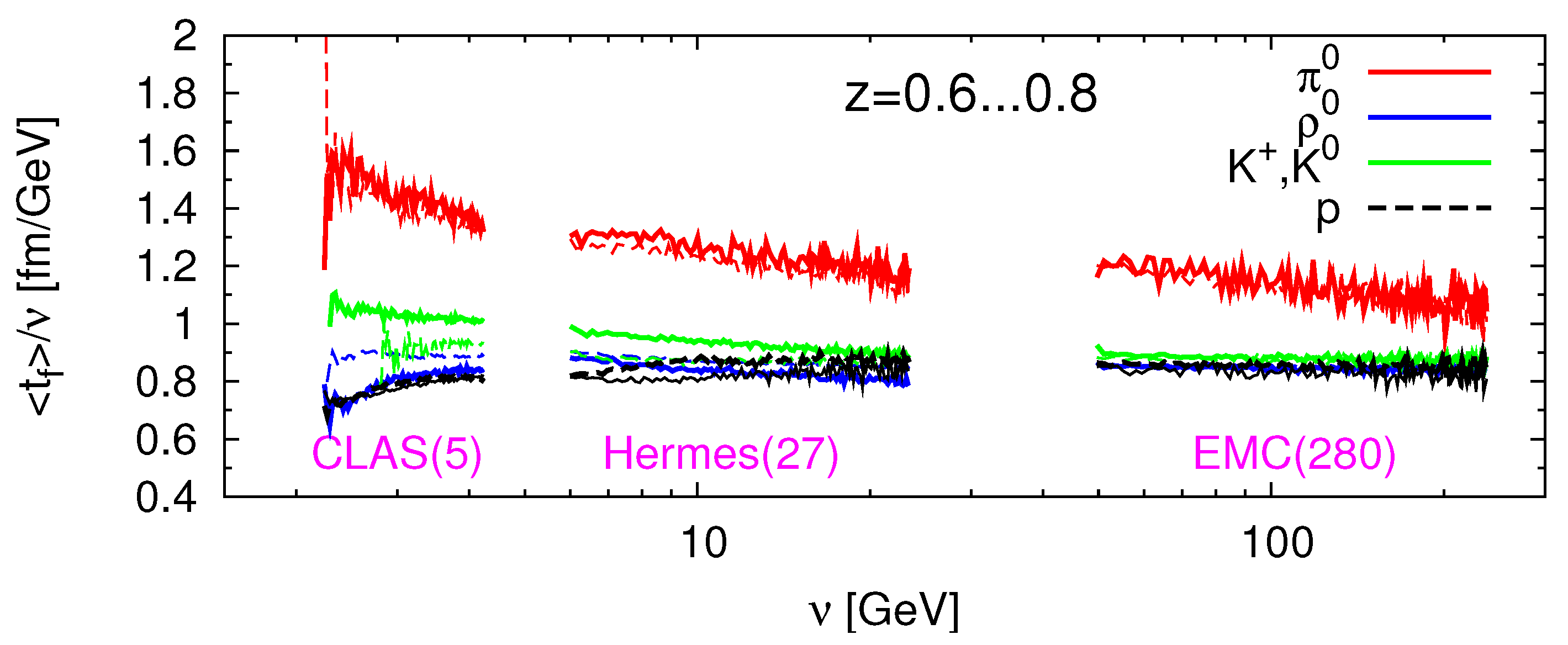
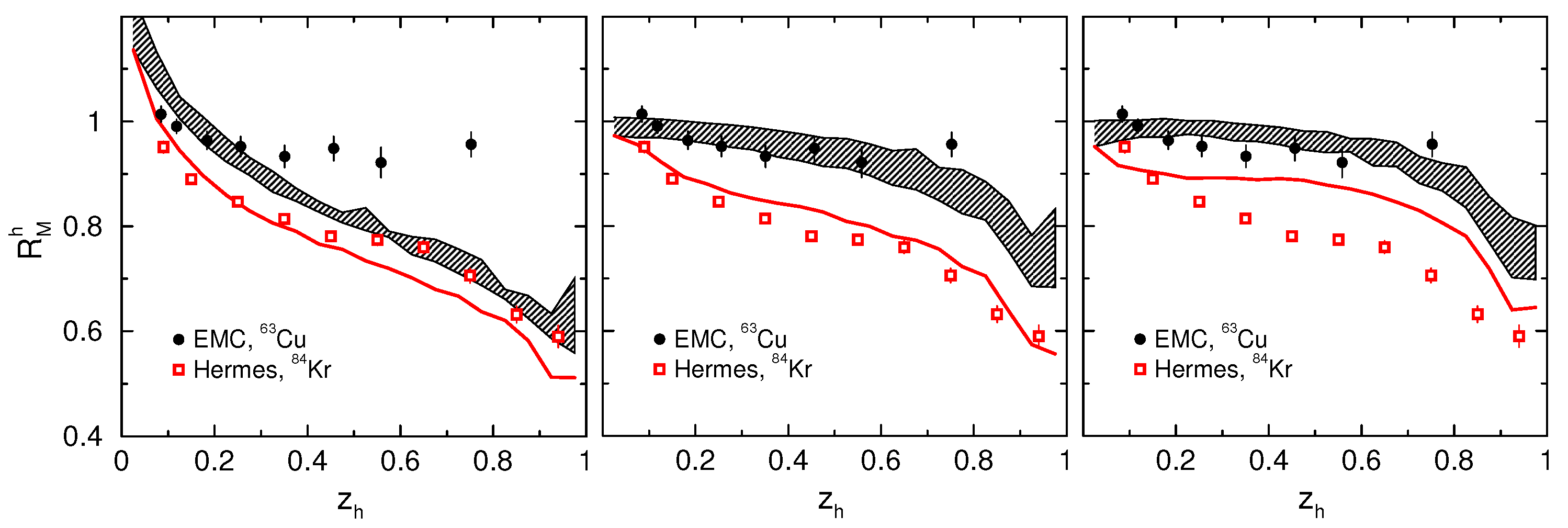
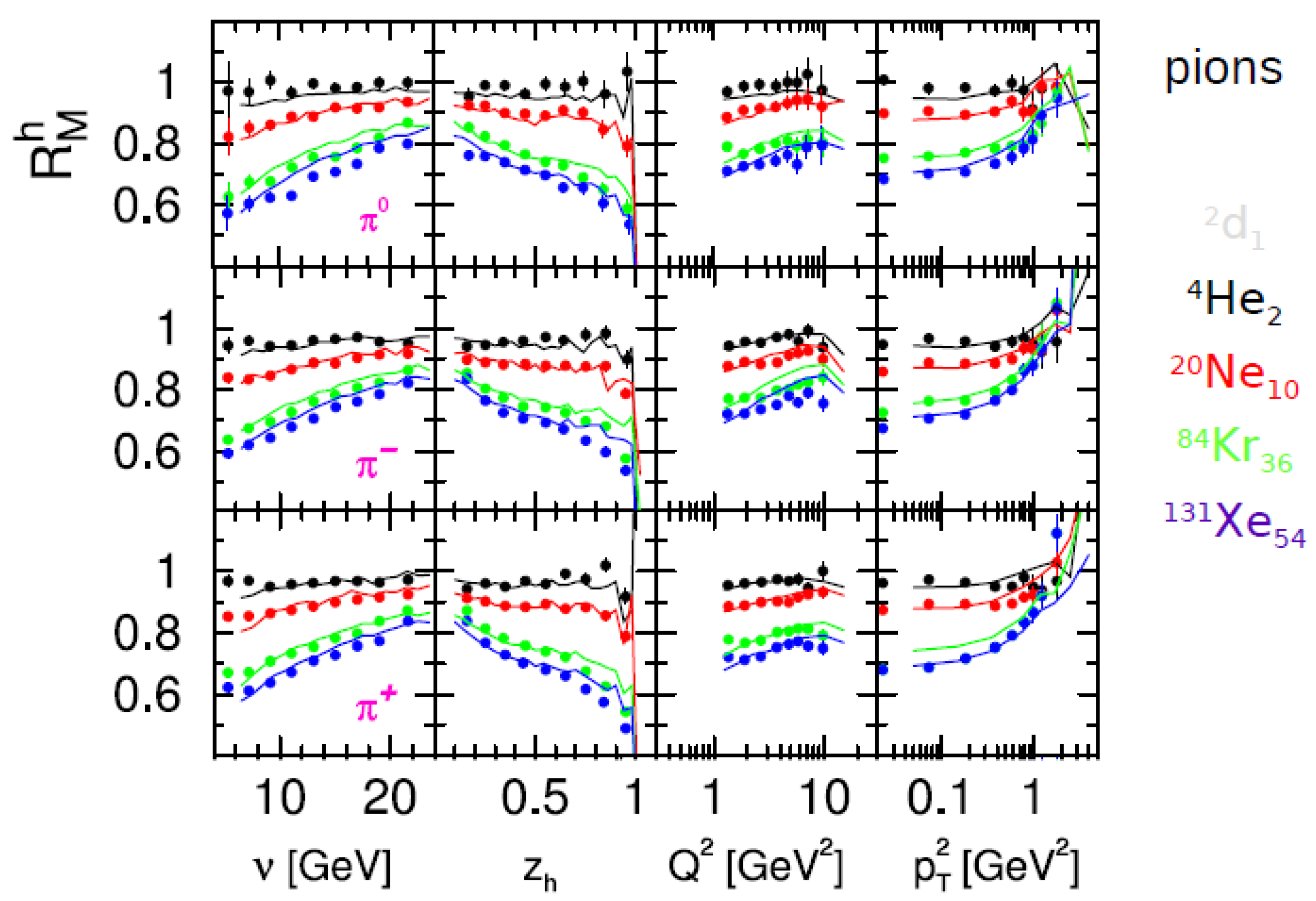
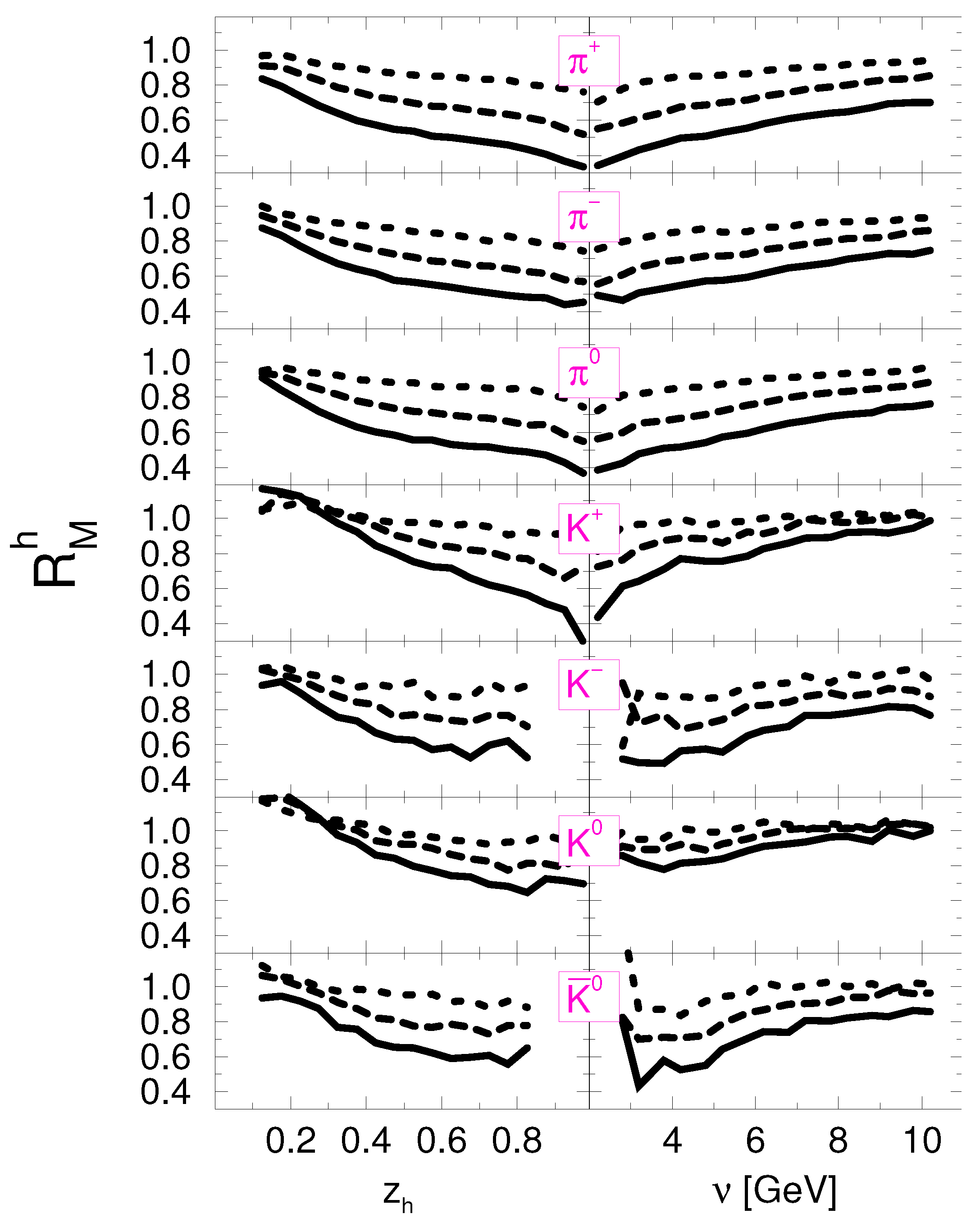
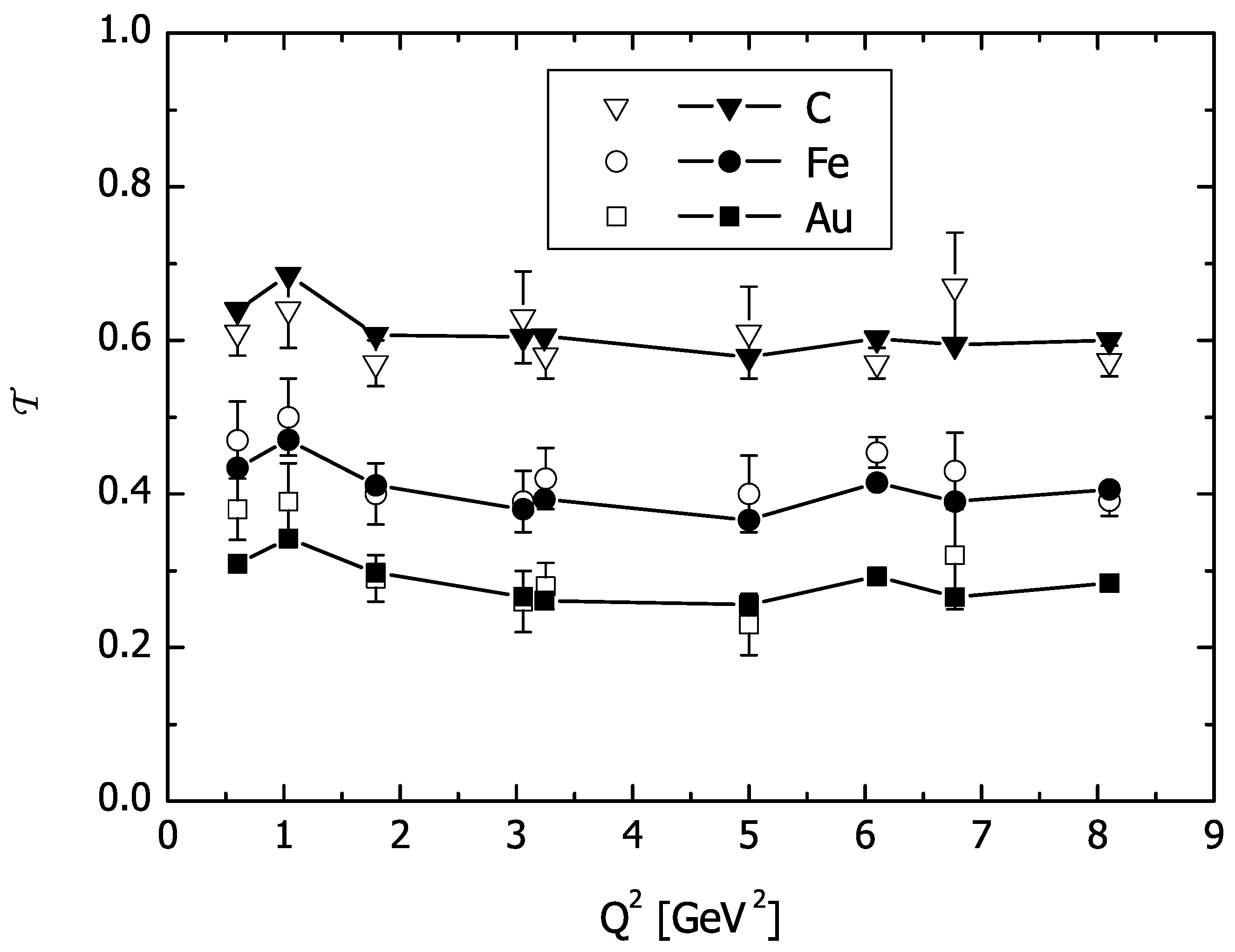
Publisher’s Note: MDPI stays neutral with regard to jurisdictional claims in published maps and institutional affiliations. |
© 2022 by the authors. Licensee MDPI, Basel, Switzerland. This article is an open access article distributed under the terms and conditions of the Creative Commons Attribution (CC BY) license (https://creativecommons.org/licenses/by/4.0/).
Share and Cite
Gallmeister, K.; Mosel, U. Hadronization and Color Transparency. Physics 2022, 4, 440-450. https://doi.org/10.3390/physics4020029
Gallmeister K, Mosel U. Hadronization and Color Transparency. Physics. 2022; 4(2):440-450. https://doi.org/10.3390/physics4020029
Chicago/Turabian StyleGallmeister, Kai, and Ulrich Mosel. 2022. "Hadronization and Color Transparency" Physics 4, no. 2: 440-450. https://doi.org/10.3390/physics4020029
APA StyleGallmeister, K., & Mosel, U. (2022). Hadronization and Color Transparency. Physics, 4(2), 440-450. https://doi.org/10.3390/physics4020029




